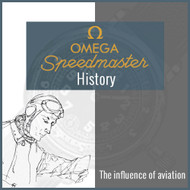Omega Speedmaster history part I : The influence of aviation
17th Jan 2020
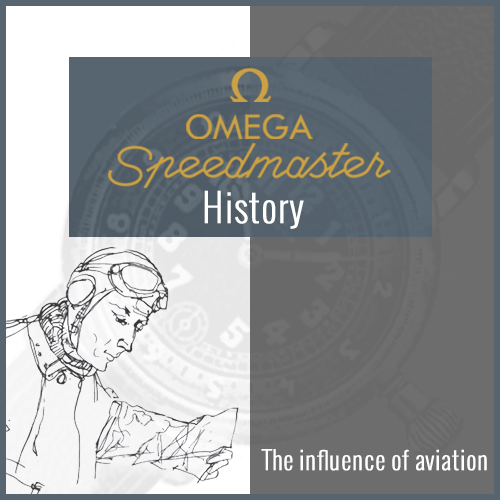
There
are many articles talking about Omega watches, and especially about
the Speedmaster and his very very famous moon mission. We want to
share our piece of information writing several posts that we hope you
find interesting and give you some extra data in addition to what we
are used to read about this model (moon, moon, space, NASA,
astronauts, moon, moon...), but don't think that we are not going to
talk about that... we will do it, that's for sure, but with some
details that many of you might don't know.
An iconic watch like the Speedmaster doesn't appear by a lucky break, as so many other times has happened. There not exist that day in which someone says: "Mr. Omega... there it is, you're welcome", The process is long, more than 40 years of evolution, with a lot of small steps until you get one of the most timeless and recognizable models of the brand and the watchmaking world.
In this first post we will focus on the first three decades of the twentieth century, which are the germ and first steps in the searching for greater precision and technical innovation.
Omega
has been linked since its beginnings to sports, aviation, motor
sport, etc. Always sponsoring great pioneer feats, linked to the
measurement of time or the use of specific mechanical instruments,
and this constant searching for excellence in time measuring made
possible the origin of the Speedmaster. The first sample of this is
in 1909, when the brand makes its debut as a sponsor in the Gordon
Bennett hot air balloon race in Schlieren, near Zurich. In this
occasion, the brand created the official 18-carat gold watches
awarded by the Swiss Aero Club as an honorary prize in the landing
contest and the balloon distance record: a 19''' Cs lepine
chronograph and two Savonnettes 19''' D chronometers with blue enamel
inscription on the back.
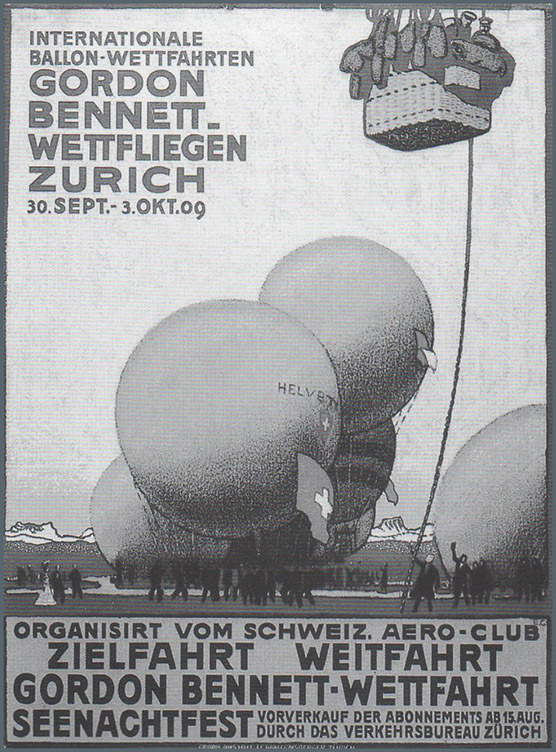
Very soon, in 1911, during a modest ceremony at the brand's headquarters, Paul-Emile Brandt presented a gold chronograph, "a wonderful precision instrument specially created for aviators and adjusted to atmospheric pressures" , to François Durafour, pilot of the Avenches Aviation School and pioneer of Swiss aeronautics, after congratulating him for his magnificent flights over the factory.
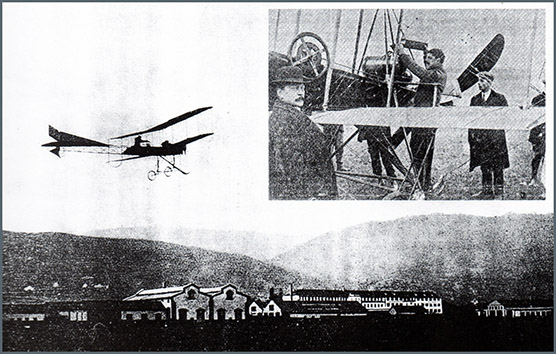
Since that experience, Omega had linked to the world of aviation, becoming visible even in a 1916 publication in the French magazine L'Illustration in an advertisement for the Paris department store Kirby Béard presenting four chronographs, one of them in bracelet version with the words "For aviator - luminous dial".
This specialization caused that British aviation chose Omega watches to equip their combat units in 1917.

Besides
personal use pieces, Omega created in 1926 its first flight
instrument (for panels), based on the double barrel 59.8 D caliber,
equipped with a rotating bezel with an internal marker to determine
the duration of the flight, "special aviation" in aluminum,
with special springs fixing and felt pads to reduce vibrations. These
pieces will be completed in the early thirties with a chronograph
version, based on the 39 CHRO caliber.
On May 27, 1931, Omega and other investors support the project of the famous professor Auguste Piccard, who along with his colleague, the Viennese Paul Kipfer, would be the first men to explore the stratosphere at 15,781 meters of altitude. Omega develops for this unique event a new, more precise, very sensitive turn coordinator, with an accuracy of one degree instead of the five used in most commercial aircraft. Even the psycho technical exams required for this adventure were done in the laboratories of the watch brand.
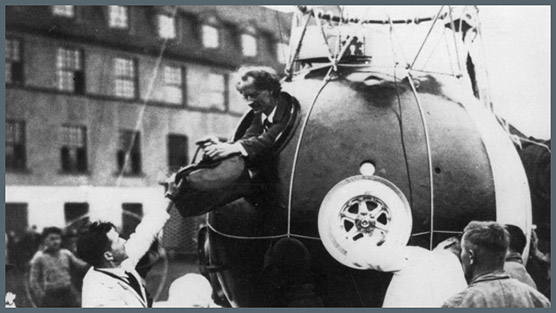
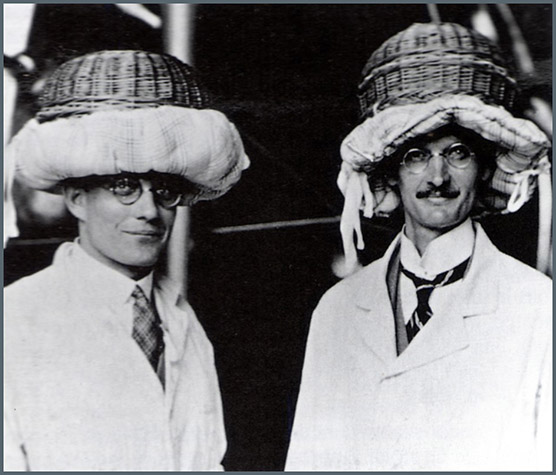
In 1933, wrist chronographs of 28.9 mm and 39 mm equipped captains and pilots, as well as the 25 seaplanes of the Italian air marshal squad, Italo Balbo, during their spectacular incursion of Rome - New York – Chicago. This event helps the brand to be recognized as an official supplier of the Royal Italian Aeronautics.
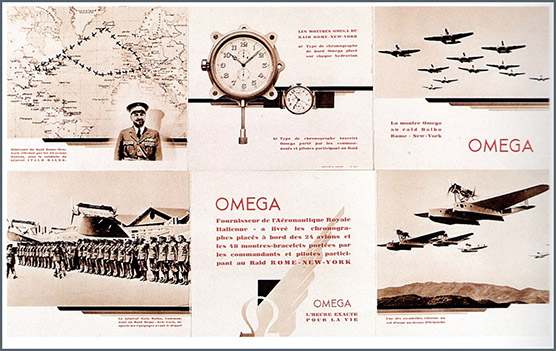
Many
creative improvements in watches and aeronautical instruments were
developed by Omega, such as the creation of a hot air model in 1935:
Located in the lower part of the aluminum and brass case, a small 12
volt heating element, turned on automatically when the temperature
dropped, so that the oils and the thermal coefficient were not
altered. It also had a rotating bezel with arrow mark and crown at 6.
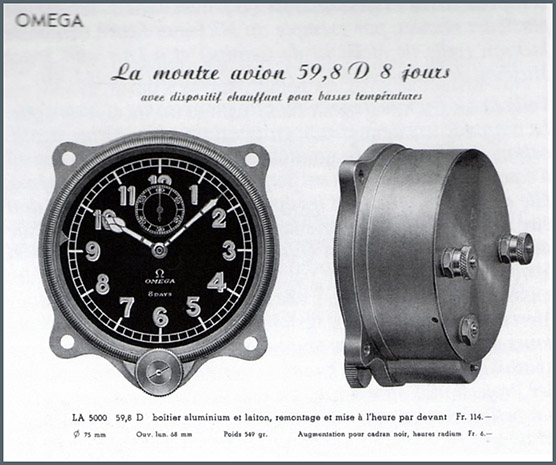
Perfectly developed, it was carried by Paul-Emile Brandt himself to be mounted on a DO-X, the Dornier seaplane with ten engines. It will be tested by the Deutsche Versuchsanstalt für Luftfahrt, whose experience on December 5 concludes as follows: "The examination of the Omega watch for airplanes at medium temperature, cold weather and vibrations has given very satisfactory results" . However, despite this success, any aviation company would buy it because of its high price. It would be the subject of a patent No. 201.042, filed in August 1937.
Omega becomes so prestigious that it becomes the first option for almost any pilot or aircraft, even was part of one of the most famous and enigmatic aviation stories, the round the world of Amelia Earhart, who was the first woman to cross the Atlantic in 1932. In 1936, the brave American aviator decides to use a 28.9 mm Omega wristwatch and a super waterproof Omega marine watch, in addition to equip her "Flying Lab" with the CHRO 39 chronograph for the solo tour around the world, which would be performed the following year with the same chronographs as Balbo.
His Lockheed Electra, equipped with two engines of 500 horse power each and capable of flying at 300 km / h, unfortunately, would be destroyed in the Pacific, where it would disappear forever on July 2, 1937.
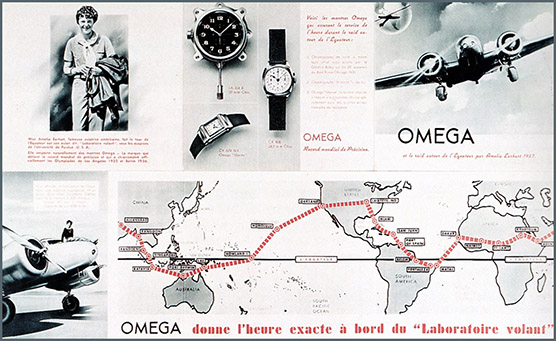
In 1938, after all the acquired experience and the appearing of new materials for manufacturing instruments and timepieces, two models of aviator wristwatches were created in Staybrite stainless steel, one in large format CK 2000 (caliber 37.6 mm ) and the smaller one CK 2042 (26.5 mm).
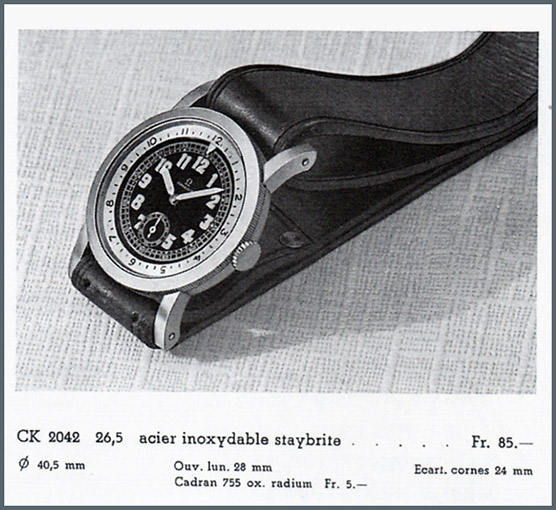
Equipped with rotating bezel and marker to determine flight duration. They were designed for use on the forearm or knee, so the straps had special designs, longer and more resistant. The 37.6 mm model had a large crown, the same style as pocket watches, but spherical, mounted on a long tube, so it could be handled with gloves.
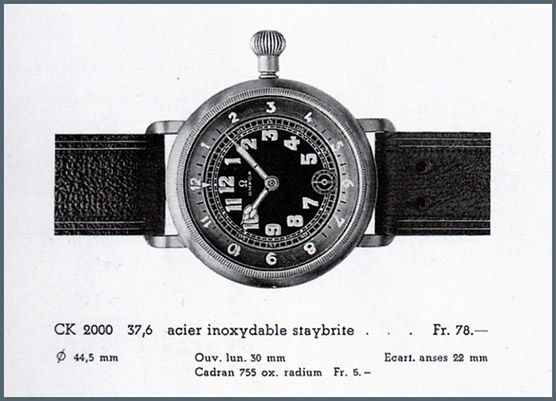
The quality standard of Omega was placed in a really high position, because the life of the aviators depended on largely of its instruments, so it's not surprising that by this time their fame was so established, that even high military charges or even scientists bet on the brand, as is clear in the testimony of the director of the United States Meteorological Services, Dr. James Kimball, who said in a letter: "... I compared my Omega with the National Observatory's stopwatch from the US, Its accuracy justifies the use of Omega watches for astronomical observations and for important flights''.
The development of the brand in 30 years is incredible, the importance of developing a specific aviation section and the audacity of being pioneers of the sponsorship of great events or magnificent adventures, such as that of Professor Piccard, kept the brand always present and create an immediate association with precision, prestige and quality.
We hope see you in the next post to move forward with the history of the Speedmaster, and tell you curiosities and data about the brand and about this magnificent piece of watchmaking history.

